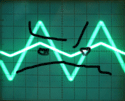|
Walked posted:This may be a stupid question, I may be a stupid person. Regardless, I've got this question: The way I see it, the negative wire of both woofers are connected directly to the ground, while their positive wires are connected to the signal. The tweeter seems to do it the other way around, judging by the plus sign at the bottom of the symbol, but I don't know enough about speakers to know if this is actually safe. But to answer your question, yeah, all three speakers are connected to the ground.
|
|
|
|

|
| # ? May 8, 2024 23:37 |
|
Assuming the source signal is just AC, all the speakers should be connected to ground, and polarity doesn't really matter (I suppose it's best if they're all the same polarity).
|
|
|
|
|
ANIME AKBAR posted:Assuming the source signal is just AC, all the speakers should be connected to ground, and polarity doesn't really matter (I suppose it's best if they're all the same polarity). I don't think that's entirely true. In one polarity the speaker will push the cone; in the opposite, it will pull the cone. Now, you might be thinking that this means you should keep all the cones wired the same way, so they're all in phase. However the problem is that your filters will also mess with the phase, so it could actually make sense to have one of your speakers flipped. Granted, I didn't do any calculations to see if this is true in this specific case, but it could be.
|
|
|
|
I wouldn't think passive filters affect phase considerably (in this application). You would want them all wired the same way, because otherwise some will be out of phase and you'll get destructive interference. The only reason the grounds wouldn't all be common would be if you wired them in series, but that doesn't really happen with a crossover network. Iono why the tweeter would be flipped but I don't know too much about crossovers.
All About Trout fucked around with this message at 01:05 on Apr 8, 2009 |
|
|
|
The filters would have to be pretty terribly designed for there to be much phase difference. Usually audio filter circuits are designed to affect phase as little as possible.
|
|
|
|
|
Walked posted:This may be a stupid question, I may be a stupid person. Regardless, I've got this question: what ? no the speakers are shown. t3, w4 and w7 are the speakers, in is your active (red wire) connect all the grounds together and to the black wire coming from your amp
|
|
|
|
In general crossovers do affect the phase considerably. But it's not really a big deal, cause plenty of speakers are like that. It's possible to build a circuit to compensate for slight differences in phase between speakers, but not necessary unless you're trying to build some super awesome crossover. You could look at the phase response of the three output nodes of that circuit in SPICE or some other simulator (make sure to include the speakers, you can estimate them as a resistance just to get a general idea).
|
|
|
|
Anyone have any advice for starting ARM development? Futurlec has some sweet ARM boards for next to nothing, and it's something I'd like to learn. (http://futurlec.com/ARM2103_Controller.shtml)
|
|
|
|
Zuph posted:Anyone have any advice for starting ARM development? Futurlec has some sweet ARM boards for next to nothing, and it's something I'd like to learn. (http://futurlec.com/ARM2103_Controller.shtml) Not sure about the availability of a good toolchain for that. The documentation left me unclear as to how it's programmed. I've used an Olimex SAM7 board, with an openOCD JTAG interface, and GCC. That was the way to go as far as I'm concerned.
|
|
|
|
catbread.jpg posted:Not sure about the availability of a good toolchain for that. The documentation left me unclear as to how it's programmed. It seems like UART0 is used for ISP programming. Hold one of the GPIO pins low during Reset and the bootloader accepts programming through some method of encoding. The software that comes with it handles all that stuff. It's the toolchain stuff that's got me confused. What dev environments are reasonably up to date? I know IAR has a "kickstart" version which will program up to 32k for free (which would be fine for this particular uC). I tried installing Yagarto, but I got all sorts of quizzical errors (Probably relating to the fact that I'm running the windows 7 beta) when I tried to compile the sanity test dummy .c file. The latest stable version of WinARM appears to be 2 years old, unless I'm blind.
|
|
|
|
I'm having a problem sourcing a common connector. DigiKey and Mouser both offer these headers: http://search.digikey.com/scripts/DkSearch/dksus.dll?Detail&name=A1927-ND that's the 640457-4 and the 640457-5. These are 4-position and 5-position headers. However I'm having a hell of a time finding the appropriate mating piece on either site. DK lists the mating products, and it seems like 644512-4 is the appropriate one, except its listed as non-stock. Indeed, this is the case for both DK and mouser! Why would they carry the header but not the connector? Do any of you guys know where I could find the appropriate connector for the 640457-4/5 header? It's a pretty common part!
|
|
|
|
Cyril Sneer posted:I'm having a problem sourcing a common connector. If you scroll to "mating connectors" and click "more" you can find some that are in stock. eg. http://search.digikey.com/scripts/DkSearch/dksus.dll?Detail&name=A19093-ND Edit: wait, that's wrong. You have to order 1000 of those. Hm. I'll keep looking.
|
|
|
|
Cyril Sneer posted:I'm having a problem sourcing a common connector. http://search.digikey.com/scripts/DkSearch/dksus.dll?Detail&name=A31129-ND; available in quantities from 1 to 4,965. Did you hit 'more' on the Mating Products section on Digi-Key? There are a ton of connectors there, and not all of them are non-stock. e: too slow Sabretooth fucked around with this message at 08:36 on Apr 13, 2009 |
|
|
|
Sabretooth posted:http://search.digikey.com/scripts/DkSearch/dksus.dll?Detail&name=A31129-ND Here we go, finally found one that's not non-stock. http://search.digikey.com/scripts/DkSearch/dksus.dll?Detail&name=A30816-ND Ugly color, though :P Edit x2: here's a white one: http://search.digikey.com/scripts/DkSearch/dksus.dll?Detail&name=A31004-ND Edit x3: Various other colors are also available. I'm partial to red: http://search.digikey.com/scripts/DkSearch/dksus.dll?Detail&name=A31122-ND Mill Town fucked around with this message at 08:40 on Apr 13, 2009 |
|
|
|
Mill Town posted:Edit x2: here's a white one: I bought a ton of these in my last digikey order but didn't think to get a punchdown tool. http://search.digikey.com/scripts/DkSearch/dksus.dll?Detail&name=A9982-ND looks like it isn't worth $20, but that's pretty cheap for a Digikey tool. Anyone have any better ideas?
|
|
|
turbo sex bat 4000 posted:I bought a ton of these in my last digikey order but didn't think to get a punchdown tool. say now, I've been looking for something like this for a while. If it's made by Tyco, then I'd say it's legit (at least for tyco parts). And again, when searching for connectors, don't use the online search function. Use a catalog (electronic or paper). I recently spent literally a week looking for a certain type of connector: a right angle, pcb mount, 4.4mm banana jack receptacle. After probably 16 hours of combined searching, I came up with one decent result: http://mouser.com/Search/ProductDetail.aspx?qs=E2gf03EXmtoqC8%2fBhoPdrg%3d%3d hopefully it works. I'm planning on doing a small production run on one of my projects this year and I want everything to be pretty much perfect.
|
|
|
|
|
I have an old set of Cambridge Soundworks DTT2500 Speakers. Recently some channels are cutting out...they just stop working, and if I fiddle with the knobs sometimes they cut back in only to cut back out again. Is there any basic thing I can look into and see if it will fix it? I've seen a couple internet posts which suggest it might be dirty potentiometers in the knobs...does that sound reasonable?
|
|
|
|
ANIME AKBAR posted:polarity doesn't really matter (I suppose it's best if they're all the same polarity). Some people can actually tell what the polarity is. There have been tests done that show this. I dont have any links, since I heard this in lecture from my professor. For the average person it doesn't matter, though. (the more you know) quote:I have an old set of Cambridge Soundworks DTT2500 Speakers. Recently some channels are cutting out...they just stop working, and if I fiddle with the knobs sometimes they cut back in only to cut back out again. Is there any basic thing I can look into and see if it will fix it? I've seen a couple internet posts which suggest it might be dirty potentiometers in the knobs...does that sound reasonable? Sounds like the wires are loose. It could also be the potentiometers, you'd probably have to open it up and look. If the wires are loose it's an easy sodering fix (most likely). Hopefully it is just a few screws you can take out and check it out(?) mitztronic fucked around with this message at 23:01 on Apr 14, 2009 |
|
|
|
ozziegt posted:I have an old set of Cambridge Soundworks DTT2500 Speakers. Recently some channels are cutting out...they just stop working, and if I fiddle with the knobs sometimes they cut back in only to cut back out again. Is there any basic thing I can look into and see if it will fix it? I've seen a couple internet posts which suggest it might be dirty potentiometers in the knobs...does that sound reasonable? Dirty pots is definitely reasonable. So is broken wires as jonmitz suggested. Open them up and spray some contact cleaner into the pots. If it doesn't get better, keep poking and flexing wires until you find ones that make the sound cut out, then replace them. Edit: most likely candidates are the wires that are outside the housing, the one that connects to your PC and/or the ones that go to the satellite speakers.
|
|
|
|
jonmitz posted:Some people can actually tell what the polarity is. There have been tests done that show this. I dont have any links, since I heard this in lecture from my professor. I believe it's less about telling absolute polarity as it is having two speakers emitting the same frequency 180 deg out of phase. Crossovers aren't perfect and there should be some overlap between them, so you want to make sure that those frequencies add coherently.
|
|
|
|
SnoPuppy posted:I believe it's less about telling absolute polarity as it is having two speakers emitting the same frequency 180 deg out of phase. Sorry I should have clarified - I meant if you have a single woofer and you switch the + and - some people can tell the difference. It didnt really have anything to do with the discussion.
|
|
|
|
why the hell are crimping tools so drat expensive? Anyone have a clue?
|
|
|
|
Zaxxon posted:why the hell are crimping tools so drat expensive? Anyone have a clue? One of the mysteries of the universe. There's no midrange for electronic/electrical tools. It makes sense to shell out when you build panels all day and need to ensure consistent crimps. The time you save not having to hunt down flaky connections pays for it pretty quick.
|
|
|
|
Zaxxon posted:why the hell are crimping tools so drat expensive? Anyone have a clue? I think it's because they sell them to contracting firms, which is kind of like selling to the army.
|
|
|
|
They're very specialized tools, and have a very small market audience. Most people wouldn't use them enough to justify the cost, and manufacturers who do need fast crimping would just use assembly machines or custom orders. So the only people who really use them are professional electricians who need crimping in any situation.
|
|
|
|
|
Zaxxon posted:why the hell are crimping tools so drat expensive? Anyone have a clue? Because crimping ain't easy
|
|
|
|
Poopernickel posted:Because crimping ain't easy
|
|
|
|
I just tried out that circuit simulator, and it's pretty cool. Something seems to be a bit amiss though. I made this charge pump based negative voltage supply design, but I didn't expect to see a full -10V output.code:
|
|
|
uhh, that's not a charge pump. Charge pumps are much simpler.Poopernickel posted:Because crimping ain't easy fffffff
|
|
|
|
|
Me and some friends had an impromptu 'poo poo that looks cool in a microwave' buildoff. Holy poo poo we had some awesome sparks. Best ones were: -Spark gap with dipole antenna made from a coke can (held together with tape) -coupled lines separated with some weird sticky goop we had lying around, connected to part of a dipole on each side -spark gap with wires from a cat5 cable making a dipole We had to have tried like 30 different ways to make sparks. I will try to get some video up at some point, phone has some weird proprietary video format. So I ask you DIY...what is the biggest baddest microwave spark you can make? Hint: A microwave is just a big oscillator firing into a cavity. Said oscillator oscillates at 2.4GHz.
|
|
|
|
clredwolf posted:Me and some friends had an impromptu 'poo poo that looks cool in a microwave' buildoff. Holy poo poo we had some awesome sparks. Best ones were: Once, I took two pieces of graphite for a mechanical pencil (0.5mm I think) and embedded them in a dish of salt (to act as an insulating base). I had the very tips of the graphite touching, like this: code:A burning tooth pick or candle is another cool thing to try.
|
|
|
|
clredwolf posted:Me and some friends had an impromptu 'poo poo that looks cool in a microwave' buildoff. Holy poo poo we had some awesome sparks. Best ones were: My favorite piece of "Microwave Magic" was taking a couple grapes, slicing them in half so that only a small flap of skin connected the two halves and sitting them on a tray, spread open. If done right, you can create these brilliant blue/red balls of fire above the grapes, which is drat cool. e: http://www.youtube.com/watch?v=_ux8nSWmAz0 Hubis fucked around with this message at 06:10 on Apr 19, 2009 |
|
|
|
Anyone done anything with electroactive polymers? Specifically I have been looking at the dielectric style. These are made up of 2 electrodes that need to flex and stretch. Between those is a thin dielectric like silicone rubber for acrylic foam. These behave like a capacitor and the electrostatic force in the parallel plates causes the dielectric to deform and the plates get closer together. If you layered these up you could contract it a good distance, maybe 5% of normal length. The downside is that you need very high voltages to do it. On the order of 10-20KV. Not very much power though, a few milliamps. On the bright side, unlike the other polymer actuators you don't need to constantly power them. Only when they are doing work. As I see it in order to make these work I need some supplies. 2 part silicone is pretty easy to get. Need to be the soft kind that has some decent give to it. Some carbon grease and fine wire for the electrodes. And a HV dc power supply, which is pretty easy to do with a voltage multiplier. First problem is the dielectric properties of the silicone are important. If you have a superior dielectric property you can charge the actuator up more and it can exert more force before breaking down. I was thinking of adding a powered dielectric ceramic of some kind. Barium titanate seems to be the standard. No idea where I will get it though. I will probably try a couple things for electrodes but more than likely activated carbon will work. So anyone done any work with these before? They seem deceptively simple. Can anyone think of where I might need to improve my initial ideas? Ideas about how to make controlled height layers of silicone and carbon would be nice as well. I'd like to use these instead of RC servos eventually.
|
|
|
|
You seem to know what you want, and I can't help you there. But in the same vein, have you or anyone looked at memory metal? I looked into them when I was thinking about minimal robots a few months back - it's fairly simple in theory: you heat filaments ohmically and they go back to their previous form providing movement, and you have some preload so that when you turn the current off the memory metal is forced away from its desired state again. I never did manage to procure any cheaply enough, though.
|
|
|
|
ANIME AKBAR posted:uhh, that's not a charge pump. Charge pumps are much simpler. ok, technically the charge pump is just the 2 caps and diodes on the end with an AC source on the left. code:
|
|
|
|
Snaily posted:You seem to know what you want, and I can't help you there. But in the same vein, have you or anyone looked at memory metal? I looked into them when I was thinking about minimal robots a few months back - it's fairly simple in theory: you heat filaments ohmically and they go back to their previous form providing movement, and you have some preload so that when you turn the current off the memory metal is forced away from its desired state again. I've thought about using it but it is pretty slow at going back to its normal shape. It has to cool enough and if I want it to contract quickly I have to put that much more heat into it. I've managed to get a copy of: Electroactive Polymers for Robotic Applications. Seems to give a pretty good overview what is needed and what attributes are important.
|
|
|
|
I'm trying to fix on older computer that has blown caps, and I cannot find replacement capacitors. I've looked through the sites listed in the OP that allowed purchases of less than 100, but I cannot seem to find replacement caps that are 6.3v, 3300uf, and are the same size as the capacitors that blew. While there is some room for bigger caps, the current size is ~12.5mm x 20mm, and the smallest I have found are 25mm x 50mm. Any ideas as to where I can find soem replacements? I need 10 or so.
|
|
|
Hillridge posted:ok, technically the charge pump is just the 2 caps and diodes on the end with an AC source on the left. http://en.wikipedia.org/wiki/Charge_pump
|
|
|
|
freezepops posted:I'm trying to fix on older computer that has blown caps, and I cannot find replacement capacitors. I've looked through the sites listed in the OP that allowed purchases of less than 100, but I cannot seem to find replacement caps that are 6.3v, 3300uf, and are the same size as the capacitors that blew. I found a couple dozen results on digikey. Anything from panasonic or nichicon should be good. Here's one from nichicon's HE series: http://search.digikey.com/scripts/DkSearch/dksus.dll?Detail&name=493-1475-ND
|
|
|
|
|

|
| # ? May 8, 2024 23:37 |
|
ANIME AKBAR posted:no, a charge pump contains no diodes. What you're showing is more like a voltage doubler, but inverting. Charge pumps work using flying capacitors and analog switches. It really is the same thing, just implemented differently. From the wiki you linked: Another way to explain the operation of a charge pump is to consider it as the combination of a DC to AC converter (the switches) followed by a voltage multiplier. The op-amp produces the DC-AC, and a voltage multiplier is just caps and diodes. Charge pump may not be exactly the right term, but it's not totally wrong either.
|
|
|





















